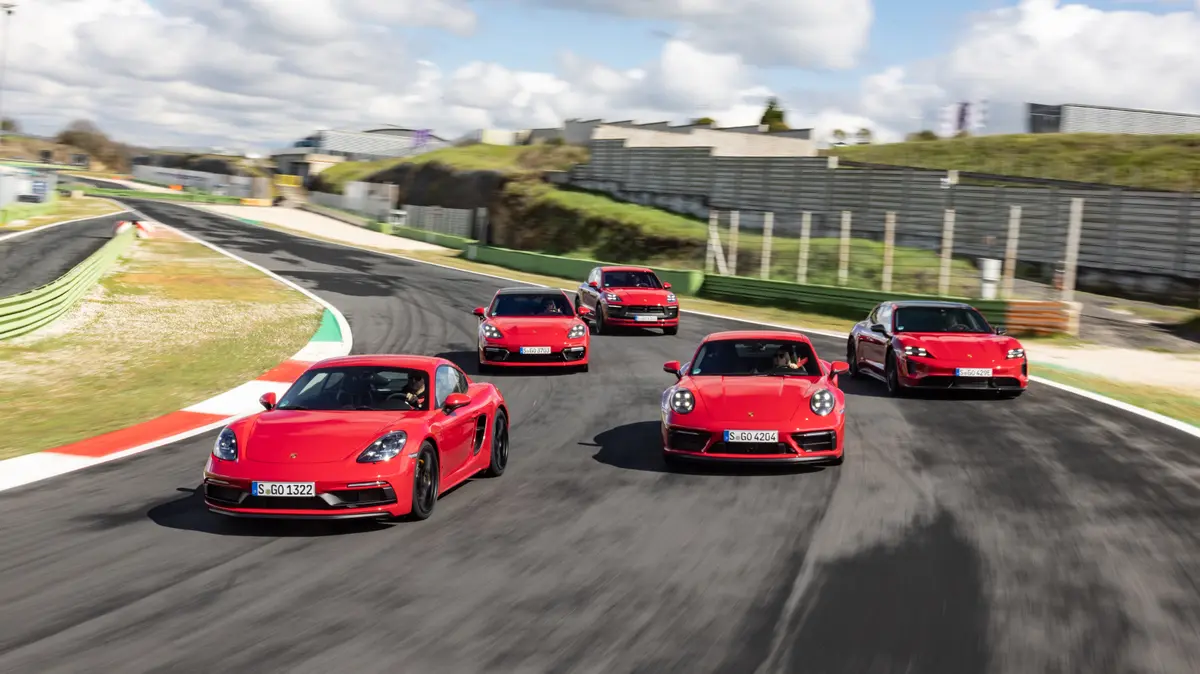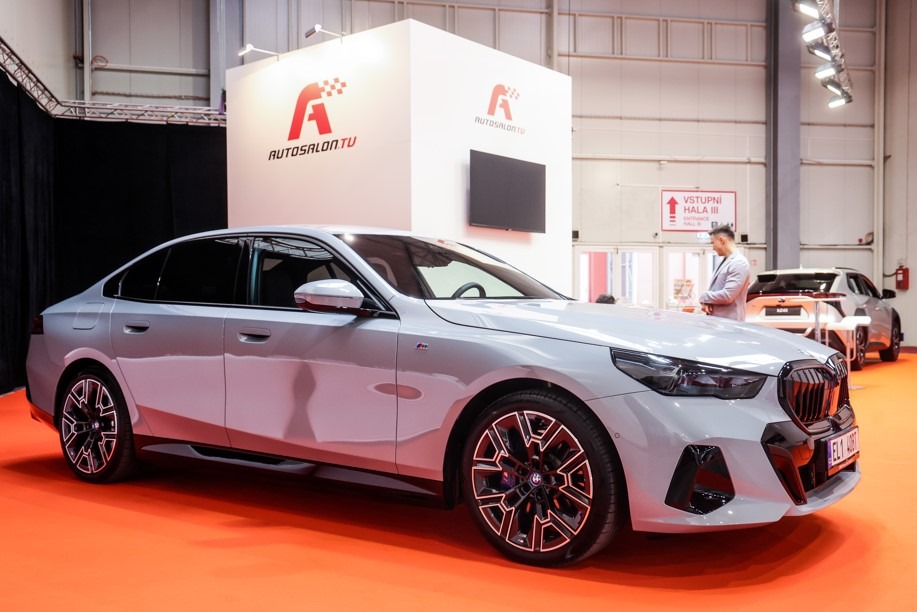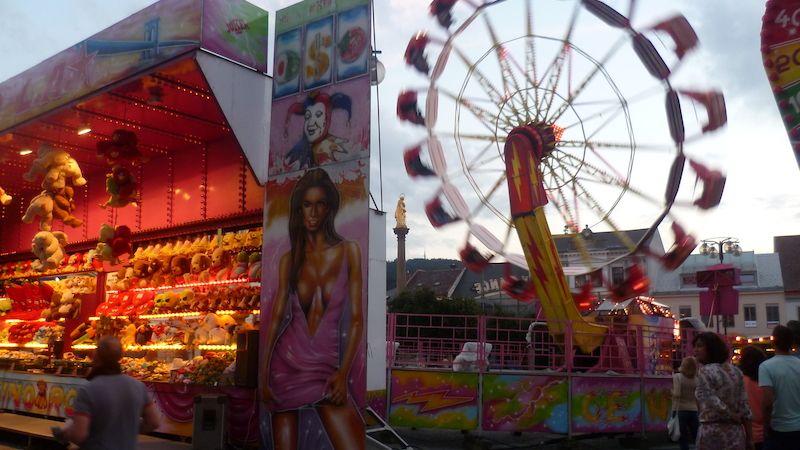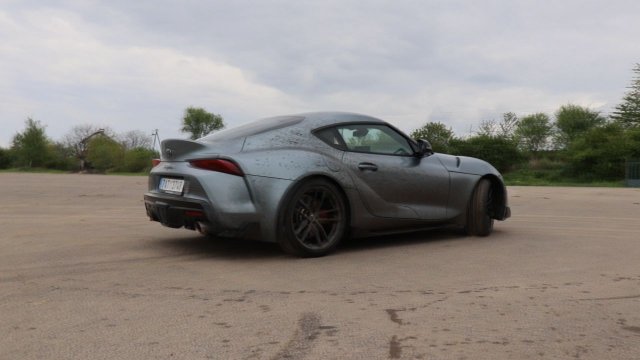The first big turn – aptly named the Curva Grande – was very dangerous. On the map, it looks like an inconspicuous graceful curve, and in a race car wearing a sticky slick, it drives at 220 km / h with only light throttle, but in a road sports car with regular tires it is different. In a straight run, you have to brake, but only lightly, so as not to lose speed in the next level. Your approximate speed of approach will then check for ripples directly at the crest, where the shock absorbers will lock properly. Whistling and short pebble ducks and hungry walls await you, but hit it right and you’re having fun on the bike.
Photo: Porsche
The Curva Grande looks easy, but watch for the tire tracks that lead straight into the ditch – an example of overconfidence or a technical failure
And that’s how the entire Vallelunga circuit is, where fast lanes are similar “at the heart” and technically demanding sections take turns, other unevenness and rubberized asphalt mixed into it, and everything is limited by fairly deep ducks. The result is a track that perfectly tests the experience and courage of the driver and the capabilities of the engine. And it will also bring a unique opportunity to directly compare the behavior of different concept cars in the form of a number of Porsche GTS sports models.
Exercise every day
The GTS (short for Gran Turismo Sport) series in Porsche’s model hierarchy matches the civilian model and the really sharp GT version. It combines the best of both worlds – it has a higher performance and sharper chassis, a modified exterior design with black lacquered elements (so experts know it at first glance) and an interior with fantastic anatomical seats and a sports steering wheel, all in all. Alcantara upholstered. At the same time, they are convenient enough for you to go to work or shop with them every day, and on weekends you can head to Rome for a workout in Vallelunz, then have a coffee at St. Mark’s Square and back to the Czech Republic. La Dolce Vita…
Photo: Porsche
The Porsche GTS family is very diverse and can be very colorful
| Show | 0-100km/h | Max. speed | |
|---|---|---|---|
| Cayman GTS | 400k | 4.5 seconds | 293 km/h |
| 911 GTS | 480k | 3.3 seconds | 309 km/h |
| GTS Panamera | 480k | 3.9 seconds | 300km/h |
| Taycan GTS | 598 k | 3.7 seconds | 250km/h |
| GTS Tiger | 440 k | 4.3 seconds | 272 km/h |
| Cayenne GTS | 460 k | 4.5 seconds | 270km/h |
The two-door sports car here is represented by the 718 series with the atmospheric engine located in the middle and the classic 911 with the supercharged engine at the rear axle. You’ll know it’s blindfolded (even if you’re going a little worse) – the Cayman with the mob near the center of the car happens to throw himself over the top and dances gracefully, while in Carrera you have to work the mob on the brakes and on its way to the end of the car , but thanks to that you can count on massive traction at the exit, where the 718 is better equipped to kick your ass.
Photo: Porsche
Porsche with the engine in the middle or the back? The difference isn’t that obvious in the district, but traveling on the circuit undresses them
You’ll also quickly notice the differences between sports limousines: The Panamera is duller in the driveway thanks to the V8 mud, but if you brake properly and watch out for understeer, it’ll cover you with rich ATV traction and the powerful roar of the V8. On the other hand, with the electric Taycan, a hot new product in the GTS series, you immediately feel the low center of gravity exerted by the battery on the floor, bringing behavior closer to a car with the engine in the middle. He also has a completely lightning reaction to gas, although above 150 km/h he starts to run out of breath compared to the Panamera which keeps moving. And the roar of the engine? So I didn’t miss the Taycan at all, the cosmic “which” of the speakers was enough for me as an underdraw.
Where did it start?
The first Porsche model with the nickname GTS was a pure racing 904 from the 1960s, which also had road homologation. But the first production model in 1980 was the heavily modified 924 GTS with extended fenders, large wings on the stern and suction cups on the hood, which concealed the supercharged two liters with a dizzying output of 245 horsepower.
Photo: Porsche
The Porsche 924 GTS is a bit more rugged in concept than the modern 911 GTS…
Well, it wasn’t a huge herd these days, but the 924 GTS could still be a scare when the turbo finally sucked in its breath at 4,000 rpm and spit out its lungs. The car is light (the interior is shaved to the bone, has no sliding windows and actually no door trim, there are two anatomically tight seats with four-point belts and nothing more), the chassis is stable and adjustable ( 16 inch tires have a 50 profile !), direct power steering and “dog paw” shifting required a firm hand – like the whole car, because that was what happened to athletes four decades ago. But even after all this time, there’s a lot of fun with this car!
Photo: Porsche
…but with speed, the new 911 is in a completely different galaxy. You won’t stop progress
It should be noted that the first modern GTS was the Cayenne SUV from 2007 and since then this sport version has been extended to the entire Porsche portfolio, including the electric Taycan.
Photo: Porsche
The GTS version has had a renaissance in recent years, initially there was the Cayenne V8, which you can even own with a manual!
It’s different in the public district, where the ride is colored by the roar, growl and roar of the V8, more intoxicating, that’s no doubt. That is, if you want to enjoy it. But when you just need to get somewhere, whether it’s a nagging city mound or boring long-range grit, the electrifying silence is actually a lot of fun. And you still don’t want to fill the eight cylinders, which even at quiet speeds say twelve liters per hundred. So if I had to choose between the two, I wouldn’t hesitate and grab the Taycan – yes, he’s great!
Photo: Porsche
Electric Taycan succeeds very surprisingly, on the circuit he is very competent and exciting, in the district there is a calming fun and comfort with him
Deciding between 718 and 911 would be much more difficult. The Boxster and Cayman have long since ceased to be “911 for the poor” – especially the atmospheric four-liter version of the GTS. This car has big character and lots of speed, while it’s small, very agile and sucks the driver (especially with a manual). Great tool for dismantling your favorite district or race track.
Photo: Porsche
Carrera, on the other hand, is more of a hammer – precise and efficient, requiring a stronger hand to squeeze it. It’s also slightly faster, of course, but keeps track of the sound of its supercharged engine (though the roar certainly won’t offend you). So which one…?
Well, I’ll leave that up to you… and that would be a good decision. Especially if you can drive it on a circuit that shows the behavior of all cars in all their nudity. Not only instructive, but also a lot of fun!

“Unapologetic social media guru. General reader. Incurable pop culture specialist.”







